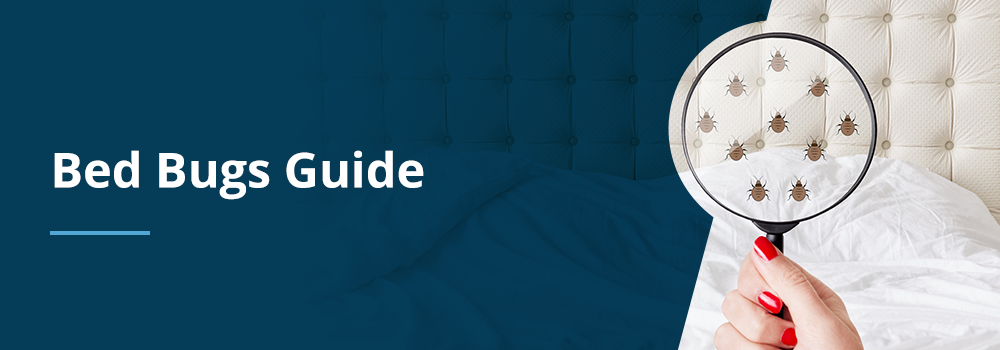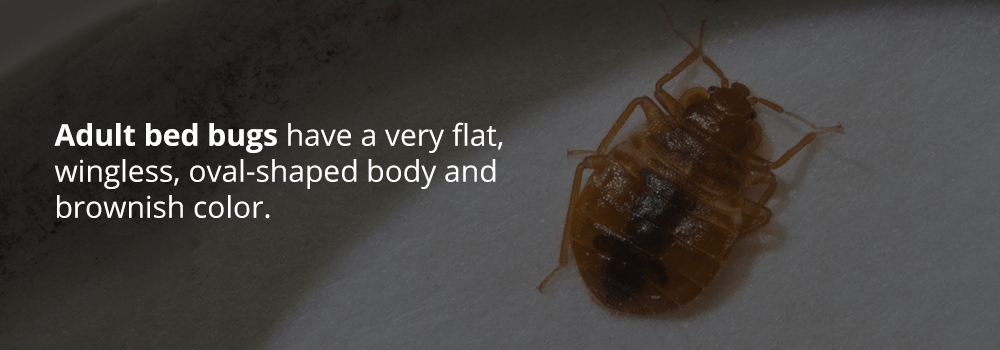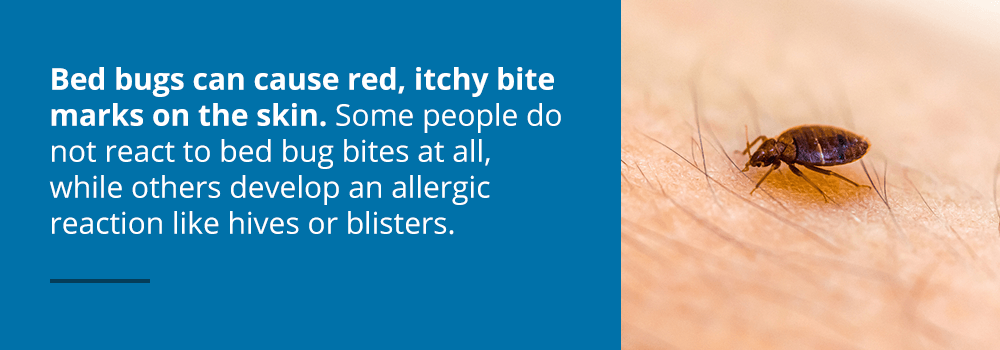Everything You Need to Know About Bed Bugs

No one ever wants to discover they have bed bugs. Bed bugs are those tiny hidden vampires that are enough to give any homeowner nightmares. These parasitic creatures are found all over the world, including our country too. They aren't picky when it comes to their living quarters, either. You can find bed bugs just about anywhere they can get a meal, from luxurious five-star hotels to movie theaters to a road side small restaurant.
Once bed bugs hitch a ride in your suitcase, cloths or purse, they'll be ready for their new home. These household pests can cause itchy and irritating bites and makeit hard to get a good night's sleep.
Bed bugs are resilient, and they are experts at hiding. In the right conditions, they can survive up to a year without food. They can also tolerate extreme temperatures for days. Bed bugs are both sneaky and nocturnal, so homeowners might not be aware of an infestation until they notice bite marks. Overall, bed bugs can be a challenge to eliminate without professional help.
If you've woken up with bed bug bites or are wondering how to identify these pests, you've come to the right place. In this guide, we'll show you everything you need to know about bed bugs so you can get them out of your home and keep them from coming back. We'll cover topics such as:
- How to identify bed bugs
- The signs and symptoms of bed bugs
- How bed bugs get into a home
- What you can do to prevent and treat bed bugs
If bed bugs have been keeping you or your family up at night, know that you can control these little bloodsuckers and get them out of your life. Keep reading to learn more, or contact us at Lifecycle Pest control and solve your bed bug problem.
Chapter 1: About Bed Bugs
Bed bugs have been pests since humans lived in caves. At least one species of bed bugs switched from feeding on bats to humans. As humans progressed and moved into houses, they likely brought the unwelcome guests with them. If you look through history, you'll find bed bugs in literature and folklore around the world, including in early Egyptian and Roman writings.
Bed bug populations drastically declined in industrialized countries during the 20th century due to the use of insecticides. However, these insecticides are no longer used, and bed bugs are making a comeback. Today, you'll find them in homes, hotels, cruise ships, airplanes and other places where they can hide and feast on blood.
If you're worried about bed bugs and want to take action, it helps to learn a little bit about them first. That way, you'll know whether you have a bed bug issue or another type of pesky visitor.
In this chapter, we'll show you how to identify bed bugs, and we'll also talk about bed bug size. If you come up with questions along the way, we're here to help at Lifecycle Pest Control.
What Are Bed Bugs?
A bed bug is a bloodsucking insect that feeds on humans and other warmblooded animals. Bed bugs belong to the Cimicidae family, which is a group of small parasitic insects. Although there are around 90 species of Cimicidae in the world that feed on birds and bats, there are only three species of bed bugs associated with humans.
Bed bugs need blood to live, grow and reproduce. According to the Environmental Protection Agency, they must eat at least once every two weeks to keep mating and producing eggs.
Bed bugs typically feed at night when their host is asleep and less likely to notice them. However, if they're hungry enough, they'll come out during the day to get a meal. This means it is possible to get bitten by bed bugs when relaxing on the couch in the middle of the day.
What Do Bed Bugs Look Like?

Adult bed bugs have a very flat, wingless, oval-shaped body and brownish color. You might say they look similar to a wood tick or an apple seed. After bed bugs eat, they take on a balloon-like shape and reddish hue. If you look closely at a bed bug, you will find horizontal lines running across its back, which allow the insect to expand as it feeds.
Bed bugs also have six long, thin legs and well-developed antennae, which they use to sense their surroundings. They have specialized sucking mouthparts that allow them to pierce the skin and draw blood. Most insects with a sucking mouthpart called a proboscis, use this straw-like organ to draw fluids from plants, but bed bugs use it for blood.
Since bed bugs do not have a set of chompers like mammals, they need to live on a liquid diet, and you won't find them snacking on food crumbs around the house. Without the right mouthparts, they can't chew through clothing, plastic or other materials. But, since bed bugs are extremely small and flat, they can squeeze through the tiniest cracks and holes.
Lastly, you might recognize bed bugs by the way they smell because they have a musty-sweet odor. However, it's unlikely you'll notice a smell unless there is a heavy infestation.
What Do Baby Bed Bugs Look Like?
In general, baby bed bugs look like adults but are smaller and may appear translucent or have a whitish-yellow color. Without a recent meal in their tummy, a baby bed bug is just about invisible.
Nymphs go through five molts before they reach adulthood. Like other insects, bed bugs have an exoskeleton which they must shed to grow. At first, young nymphs are light in color, but as they feast on blood and go through each stage, they get bigger and darker. Bed bugs need to eat before moving onto the next stage.
How Big Are Bed Bugs?
Adult bed bugs are between 3/16 and 1/4 inch long or about the size of an apple seed.
Can You See Bed Bugs With the Human Eye?
Even though bed bugs are tiny, you should be able to see adult bed bugs without a magnifying device. On the other hand, baby bugs are easy to overlook due to their light coloring and even smaller size.
Can Other Bugs Be Mistaken for Bed Bugs?
You might misidentify bed bugs because there are a lot of insects that look similar, such as:
- Carpet beetles
- Fleas
- Spider beetles
- Booklice
- Cockroach nymphs
- Bat bugs
- Ticks
Remember, bed bugs can’t jump like fleas or fly like carpet beetles.
Can You See Bed Bug Eggs?
While they are incredibly tiny and may be challenging to see, the eggs and nymphs should be visible to the naked eye. That's because bed bug eggs are about 1 millimeter long, or about the size of a pencil point.
Females lay between one and three eggs per day and up to 500 eggs during her lifetime. You might find eggs in clusters or individually in cracks or crevices.
What Do Bed Bug Eggs Look Like?
Bed bug eggs are very small and white. Eggs that are more than five days old have an eyespot.
Bed bugs eggs are covered with a sticky substance that holds them in place and makes them difficult to remove. After the eggs hatch, the shells often remain stuck to a surface.
How Long Can Bed Bug Eggs Lay Dormant?
At room temperature, bed bug eggs hatch in around 10 to 15 days. After that, the insects need to have a meal before developing into the next stage. In general, bed bugs can go between 20 and 400 days without eating, but adults are better at surviving without food than nymphs.
How Long Can Bed Bugs Live?
If there's always a meal available and the environment is kept at a comfortable temperature, adults typically live six to 12 months. However, bed bugs can live for an exceptionally long time without food as well, especially in colder temperatures. For example, in temperatures less than 13 °C, bed bugs can live a year or longer without food. In temperature-controlled environments, such as homes or buildings people use, bed bugs usually live two to six months without eating.
How Long Do Bed Bugs Live in a Plastic Bag?
Since bed bugs can live for months without food, using a plastic bag to treat bed bugs should not be the only method of control. Plus, they can easily slip through any break in a plastic bag. While bed bugs might eventually starve to death in a completely sealed bag, you'll still want to take other steps to ensure you've eliminated bed bugs and their eggs from your home.
What Can Bed Bugs Do to Humans?
Bed bugs can cause red, itchy bite marks on the skin. Some people do not react to bed bug bites at all, while others develop an allergic reaction like hives or blisters. Scratching the bites could lead to a secondary infection, especially in individuals with weakened immune systems.
For many people, the psychological effects of bed bugs are worse than the bites.

Bed bugs can cause stress, anxiety and insomnia. No one wants to go to bed thinking they're on the bed bug menu. In addition, many people worry about how friends and family will feel if they know they have bed bugs. Even though bed bugs will infest any area they can get blood, including clean homes, people might associate bed bugs with dirtiness, which can also add to a homeowner's stress.
Are Bed Bugs Dangerous?
In most cases, bed bugs aren't dangerous — they're more of an annoyance than anything. According to the Centers for Disease Control and Prevention, bed bugs are not known to spread diseases to humans.
Although viruses, bacteria, parasitic worms and other disease-causing agents have been found in bed bugs, these agents do not reproduce in bed bugs. Only a few survive in the insects for any length of time.






